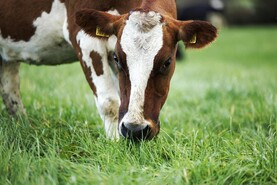California produces twice as much agriculture revenue as the next biggest agricultural state. It is home to over 350 different crops and 20% of US dairy. However, the state has the worst air quality in the US and has a loud group of activists seeking their own definition of sustainability and animal welfare rights.
The California dairy industry once had a waiver on emissions targets. When the legislation changed the industry was sued by environmental groups for not setting effective enough targets.
The conference was organised by the clean transport and energy consultants, GNA. While the company specialises in giving transport companies the technology and skills to switch to renewable fuel such as biogas, it sees an opportunity in broadening that to the dairy industry.
“We are working with the state in partnership and are on track to reduce methane emissions by 40%,” Michael Boccadoro, executive director of Dairy Cares, told the 600-strong audience. “California must go to 100% clean energy by 2045. Over 100 dairies have installed solar energy on their farms.
It’s important we understand that reducing our dependence on fossil fuels improves air quality. Through renewable natural gas we can create carbon negative transportation.”
The Californian dairy industry had 12 anaerobic digestors a few years ago but now boasts 120. California produces $65bn (€57bn) in dairy products and 189,000 jobs. Boccadoro states that the dairy industry are the “original environmentalists”.
The more money people make, the more likely they are going to move their dietary patterns to a more animal based diet
“Since World War II we have reduced the amount of land needed to produce a litre of milk by 90%. 75% to 80% of what we give our cows is inedible for humans and would end up in landfill.
“We have 400 commercially grown crops in California and every one of them can be fed to cows. Water is the limiting factor. How we handle that up and down the chain is very important. Maybe we need to filter out the solids from our effluent.”
Forty per cent of the biofuel investments in North America are taking place in California. The state created a federal dairy digestor task force.
“We went after climate change investment dollars to put money into digestors,” said Karen Ross, secretary of the Californian department of food and agriculture. “Not only are we in a state that has 40m residents that drive the voting patterns, it is a state with huge pressures from that population. It’s not just the policies they vote for but looking at our supply chain. Millennials want transparency and the opportunity to make a connection with who is producing their food.”
Through state subsidised systems, 63 digesters were funded.
Our biggest Achilles heel is the food waste, 40% of all food produced in the US goes to waste. What I find shocking is, that number holds true globally, even in developing countries,” Professor Frank Mitloehner from UC Davis told California’s first dairy sustainability conference held in Sacramento on 27 November.
With the world’s population set to reach 10bn by 2050, California is also seeking out ways to feed the additional people without an increase in natural resources.
“Demand for meat and milk is growing. Demand for animal protein will grow by 70%. The more money people make, the more likely they are going to move their dietary patterns to a more animal based diet,” Mitloehner said. He added that many of the facts activists use to encourage people to switch to a plant based diet come from a 2006 report called ‘Livestock’s long shadow’. Mitleohner and a team of grad students compiled a further report refuting its claims. He says the methodology was flawed because, while it used the full life cycle of animal production, when it looked at the transport sector it just looked at exhaust fumes.
“A classic apple and orange comparison. The authors admitted we were right. The problem is that all the people who loved ‘livestocks long shadow’ were desperate because their main argument was lost. The authors retracted key findings but critics held on to it.
“This industry has been too quiet for too long. There is an alliance of organisations out there hitting on animal production in a way I have never seen before.”
According to figures from the US Environmental Protection Agency (EPA) transport makes up 25% of emissions, agriculture accounts for 9% and within that, animal agriculture is 4%. The world’s population still needs to be fed and Mitloehner says the way forward is efficiency. He says America is the most carbon efficient producer of a litre of milk in the world.
“We produce so much milk per cow per year that our relative GHG emissions are the smallest in the world. Production intensities and emission intensities have a direct relationship. One cow here produces 20 times more than a cow in India.”
This is due to improvements in reproductive efficiency, vet practices, genetics of plants and animals and more energy intense diets. In 1950 there were 25m dairy cows in the US, today there are 9m cows producing 60% more milk.






 This is a subscriber-only article
This is a subscriber-only article










SHARING OPTIONS: